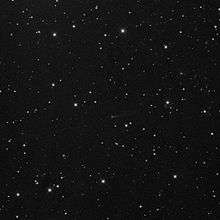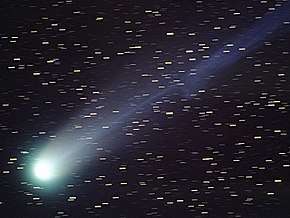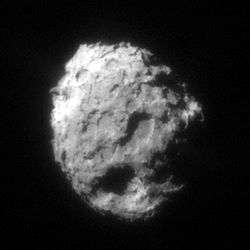209P/LINEAR
209P/LINEAR is a periodic comet discovered on 3 February 2004 by Lincoln Near-Earth Asteroid Research (LINEAR) using a 1.0-metre (39 in) reflector.[1] Initially it was observed without a coma and named 2004 CB as a minor planet or asteroid, but in March 2004 Robert H. McNaught observed a comet tail which confirmed it as a comet.[5] It was given the permanent number 209P on 12 December 2008 as it was the second observed appearance of the comet.[6] Prediscovery images of the comet, dating back to December 2003, were found during 2009.[5] Arecibo imaging in 2014 showed the comet nucleus is peanut shaped and about 2.4 km in diameter.[7][8] The comet has extremely low activity for its size and is probably in the process of evolving into an extinct comet.
 | |
| Discovery | |
|---|---|
| Discovered by | LINEAR 1.0-m reflector[1] |
| Discovery date | 3 February 2004 (asteroidal) 30 March 2004 (tail) |
| Alternative designations | 2004 CB |
| Orbital characteristics A | |
| Epoch | 2014-May-23 (JD 2456800.5)[2] |
| Aphelion | 4.952 AU (Q) |
| Perihelion | 0.9695 AU (q) |
| Semi-major axis | 2.961 AU (a) |
| Eccentricity | 0.67258 |
| Orbital period | 5.09 yr |
| Inclination | 21.243° |
| Earth MOID | 0.05 AU (7,500,000 km)[3] |
| Last perihelion | 2019-Jun-12[2] 2014-May-06[4] 2009-Apr-15[4] |
| Next perihelion | 2024-Jul-14 |
209P/LINEAR was recovered on 31 December 2018 at magnitude 19.2 by Hidetaka Sato, but not officially announced yet.[9]
2014 passage
209P/LINEAR came to perihelion (closest approach to the Sun) on 6 May 2014.[4] On 29 May 2014 the comet passed 0.0554 AU (8,290,000 km; 5,150,000 mi) from Earth,[3] but only brightened to about apparent magnitude 12.[10] The 2014 Earth approach was the 9th closest known comet approach to Earth.[11]
Associated meteor showers
Preliminary results by Esko Lyytinen and Peter Jenniskens, later confirmed by other researchers, predicted[12][13][14] 209P/LINEAR might generate the next big meteor shower which would come from the constellation Camelopardalis on the night of 23/24 May 2014. It was possible that there could be 100 to 400 meteors per hour.[12] All the trails from the comet from 1803 through 1924 were expected to intersect Earth's orbit during May 2014.[12] The peak activity was expected to occur around 24 May 2014 7h UT when dust trails produced from past returns of the comet could pass 0.0002 AU (30,000 km; 19,000 mi) from Earth.[14] The 2014 Camelopardalids only generated 10–15 visual meteors per hour.[15][16] But the expected radiant and date of visual maximum were correctly predicted.[16] The shower peaked around 6h UT on 24 May 2014.[16] The Canadian Meteor Orbit Radar (CMOR) detected the shower using HF/VHF radar echos but the particles were too small for visual detection. Earth will encounter the 1939 stream around 24 May 2019 8h UT with a ZHR of ~5. The Eta Aquariids also occur at this time of year.[17]
209P/LINEAR may also be the source of the weak 6–14 June meteor shower "sigma Ursae Majorids" (SIM #677).[11]
References
- "IAUC 8314: P/2004 CB; 2004ba, 2004bb". IAU Central Bureau for Astronomical Telegrams. 2004-03-31. Retrieved 2012-10-03.
- "209P/LINEAR Orbit". Minor Planet Center. Retrieved 2014-05-09.
- "JPL Close-Approach Data: 209P/LINEAR" (last observation: 2014-05-26; arc: 10.48 years). Retrieved 2012-10-03.
- Syuichi Nakano (2011-10-31). "209P/LINEAR (NK 2142)". OAA Computing and Minor Planet Sections. Retrieved 2012-10-03.
- Gary W. Kronk. "209P/LINEAR". Cometography. Archived from the original on 2014-05-03. Retrieved 2014-05-03.
- "IAUC 9005: COMET P/2008 X4 = P/2003 K2 (CHRISTENSEN); 208P; V5580 Sgr". IAU Central Bureau for Astronomical Telegrams. 2008-12-12. Retrieved 2012-10-03. (password required)
- "Arecibo Observatory Sees Comet 209P/LINEAR". Universities Space Research Association (USRA). 2014-05-29. Archived from the original on 2014-05-29. Retrieved 2014-05-29.
- Arecibo Radar [@AreciboRadar] (23 May 2014). "We saw comet 209P/LINEAR with radar! Looks like a narrow 2-kilometer bowling pin or peanut. Huzzah radar of comets!" (Tweet) – via Twitter.
- http://www.aerith.net/comet/recovery.html
- Alan Hale. "455. COMET 209P/LINEAR P/2008 X2". Earthrise Institute (Southwest Institute for Space Research). Retrieved 2012-10-03.
- Peter Jenniskens. "May Camelopardalids". SETI Institute. Retrieved 2014-05-25.
- "The next big meteor shower". IMCCE. Archived from the original on 2012-10-06. Retrieved 2012-10-03.
- "209P-ids 2014: prediction of activity". Archived from the original on 2014-04-14. Retrieved 2014-04-13.
- Wiegert, Paul A.; Quanzhi Ye (2013). "Will Comet 209P/LINEAR Generate the Next Meteor Storm?". Monthly Notices of the Royal Astronomical Society. arXiv:1311.0235. Bibcode:2014MNRAS.437.3283Y. doi:10.1093/mnras/stt2127.
- "Camelopardalids meteor shower a bust, but not a surprise". The Washington Post. 2014-05-24. 10:07AM. Retrieved 2014-05-24.
- "Camelopardalids 2014: First Results". International Meteor Organization. Archived from the original on 2014-05-25. Retrieved 2014-05-25.
- "Meteor Activity Outlook for May 24-30, 2014". Archived from the original on 2014-05-25. Retrieved 2014-05-24.
External links
- Orbital simulation from JPL (Java) / Horizons Ephemeris
- 209P/LINEAR – Seiichi Yoshida @ aerith.net
- Elements and Ephemeris for 209P/LINEAR – Minor Planet Center
- 209P/LINEAR at the Minor Planet Center's Database
- 209P/LINEAR – Kazuo Kinoshita (Dec. 21, 2008 )
- Camelopardalids 2014: First Results
- May Camelopardalids (SETI Institute / Peter Jenniskens)
- May Camelopardalids Fireball as seen from Pennsylvania via NASA Meteor Watch on Facebook
- How Scientists Chased a New Meteor Shower from the Sky (Space.com June 10, 2014)
- May Camelopardalids (MCM) May 24 2019 by CMOR radar
| Numbered comets | ||
|---|---|---|
| Previous 208P/McMillan |
209P/LINEAR | Next 210P/Christensen |

